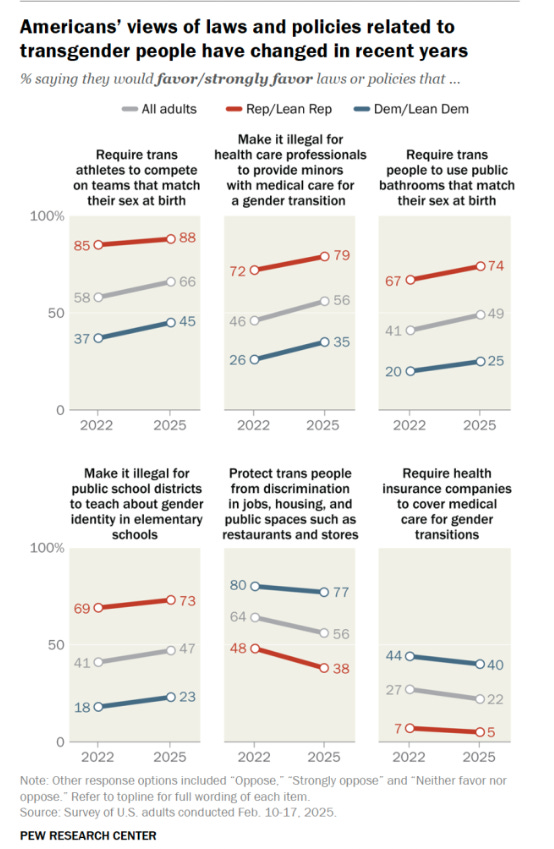It’s Official: Moms Are Harder on Themselves Than Dads, and Other Interesting New Research
The Bipartisan Vibe Shift on Trans Issues; Are Husbands Really Abandoning Their Sick Wives?; Get Your Adult Kids to Talk to You With This One Simple Trick (Give them Money) + more.
Happy Tuesday!
A note before I get into this week’s round-up: I made a correction to last week’s round-up regarding the study suggesting that maybe moms don’t actually want to work from home after all. But rest assured that the takeaway of interest—that moms of young kids want to work from home less than other women—is still accurate!

Religiously Mixed Couples, and the Highly Religious Parents Who Don’t Pray With Their Kids
A while back, I covered a study making the case that the rise of religiously-mixed couples has accelerated fertility decline in Finland. A fresh Pew survey has found that about three-quarters of currently married U.S. adults share the same religion as their spouse. That share hasn’t budged much since 2014 (75%). So at least by this metric, religious intermarriage hasn’t increased much in America over the past decade. That said, they also find that people who share the same religion as their spouse tend to be more religious than those married to someone of a different religion. So for example, 46% of Catholics married to other Catholics are highly religious, considerably higher than the 24% of Catholics married to non-Catholics. I imagine this helps to explain why religiously mixed Finnish couples have fewer kids than religiously matched ones!
One sort of surprising (to me) finding is that 81% of highly religious parents pray or read scripture with their kids. That strikes me as…sorta low. I think I assumed that not praying with your kids disqualified you from the “highly religious” label. But then I only say that because I come from a highly religious Catholic family and I’m pretty sure if I didn’t pray with my kids, my dad (RIP) would stage an intervention from beyond the grave. “A family that prays together stays together,” and all that. Also interesting: 13% of religiously unaffiliated parents do pray or read scripture with their kids. A lot of that is driven by religiously unaffiliated folks who identify as “nothing in particular” rather than atheist or agnostic. Still 2% of surveyed atheists and 4% of agnostics pray or read scripture with their kids!
The Bipartisan Vibe Shift on Trans Issues
Another new Pew survey found that a growing majority of Americans support restrictions for trans people. So, for example, 66% say trans athletes should have to compete on sports teams that match their sex assigned at birth, and 56% say healthcare professionals shouldn’t be allowed to facilitate gender transition for minors. That’s up from 58% and 46%, respectively, in 2022. Likewise, only 22% of Americans think health insurance companies should be required to cover the medical costs of transition, down from 27% in 2022. Most adults (56%) support measures that would protect trans people from employment or housing discrimination, but that too is down from 64% in 2022.
Importantly, the trends observed in the survey are fairly bipartisan. The share of democrats who want to restrict gender transition for minors is up 9 percentage points since 2022. Support for requiring trans athletes to compete on teams that match their sex at birth is up 8 percentage points among democrats. There are still big partisan gaps, but generally speaking, members of both parties are moving in the same direction.
The Class Gap in Screen Time
Commons Sense released a new report on media use among kids aged zero to 8. If you want a pretty thorough breakdown from someone who really knows what they are talking about, I recommend this summary by
over at Techno Sapiens. Here, I’ll highlight a couple of things. On average, kids under 8 are spending 2 hours and 27 minutes a day on screens, the vast majority of which is spent watching videos or gaming. There is a lot of variation in daily screen time by age: among kids under 2, it averages about an hour, but it rises to 3.5 hours among those in the 5 to 8 range.The class gap that emerges in the data is pretty striking. Children from households on the lower end of the income spectrum (less than $50,000 per year) spend nearly 4 hours on screens daily, about double the screen time of kids in higher income households ($100,000 plus). By comparison, children in the 0 to 8 age group spend an average of 32 minutes a day reading or being read to, which hasn’t changed much since 2020.
When it comes to daily reading, the class gradient moves in the opposite direction: “Children from higher-income households are more likely to read or be read to daily (61%) than those from middle-income (51%) and lower-income households (41%).” The same basic pattern holds for parental education and reading frequency. The relationship between class and average time spent reading was a little more ambiguous, and seemed to depend on whether or not you are talking about e-reading, or print reading. But I’ll let you draw your own conclusions from the Table below.
It’s Official: Moms Are Harder on Themselves Than Dads
Okay, so the aim of this study was to figure out how parents of different genders and socioeconomic backgrounds rate themselves as parents, with an eye for figuring out how various groups (mothers vs. fathers, highly educated parents vs. parents with little education) actually define “good” parenting.

Broadly speaking, the odds of a parent giving themselves high marks are 28% higher for mothers than for fathers, and 13% higher for college-educated parents than those with less education. But there is considerable variation in “parental inputs,” so to speak, across gender and class. Mothers, for example, have higher levels of parental engagement and are more likely to co-reside with their kids than fathers, but they also have lower earnings, are more likely to be unemployed or work part-time, and are less likely to work long hours. When you hold these factors constant, the higher self-rating among college-educated parents shrinks and is no longer statistically significant. And the gender gap actually reverses—that is, given the same level of parental involvement, mothers are actually less likely than fathers to rate their parenting highly. In other words, mothers have higher standards: they need to do more than fathers in order to achieve the same self-evaluation. To visualize this gender gap, the authors estimate self evaluations in a variety of scenarios, while holding parental inputs constant. As you can see in the figure below, in multiple different arrangements, dads are more likely than moms to give themselves the highest marks.

Another interesting thread of findings here is that while there seemed to be some differences in what mothers and fathers consider good parenting, there wasn’t much difference by class. For both mothers and fathers, more parental engagement led to a better self evaluation, as did working full-time. But earnings and home-ownership were only associated with fathers’ self evaluations. And whereas “overwork” (working long hours) didn’t seem to have any sort of bearing on a mothers’ self evaluation, dads who overwork actually rate themselves higher. Meanwhile, they didn’t really find any educational differences in what sort of measures of parental involvement and financial provision were associated with good parenting—so parents of different classes seem to be assessing themselves according to the same rubric, even if mothers and fathers aren’t.
Get Your Adult Kids to Talk to You With This One Easy Trick (Give Them Money)
Having kids is great, but how do you ensure that they keep in touch with you after they’ve flown the coop? This study investigates whether or not giving your kids cold, hard cash can do the trick. And guess what: it can! Basically, the authors use longitudinal data from a bunch of European countries between 2004 to 2015 to examine “the extent to which gifts influence the frequency of children’s contact with their parents.” They find that financial transfers causally increase social contact between parents and their adult children. The effect was stronger in families without any grandchildren, which could be due to the fact that perhaps grandparents might provide non-monetary support to their adult children in the form of childcare, thus “reducing the need for gifts as a further signal of appreciation for social contact.”
Seems Interesting*
Are Husbands Really Out Here Abandoning Their Sick Wives?
Background: In 2015, a study was published that suggested that a couple’s risk of divorce increases when the wife is sick, but not when the husband is. It seemed to confirm the findings of another 2009 study, which came to a similar conclusion: that a wife’s illness is a greater threat to marital stability than a husband’s. The findings of the 2015 study were pretty widely covered, but unfortunately the study itself was swiftly retracted after it turned out that the weird gender split was due to a coding error. To my knowledge, the 2009 study hasn’t been retracted, but with the drama around the 2015 one, it’s sort of hard to know whether this whole theory has any legs.
This study, which examined how health impacts the likelihood of so-called “silver splits” among heterosexual couples in Europe, did find a gendered association between health and breaking up for couples in the 50-64 age range. “Couples in which the woman reported poor self-rated health or faced severe activity limitations, whereas the man maintained good health, exhibited a higher risk of silver splits compared to couples in good health.” Meanwhile, split risk doesn’t really change when it’s the man with poor health or activity limitations. The gendered link between health and break up risk weakened with age, and it curiously didn’t show up when it came to depression.
Why is Suicide So Common Among Female Physicians?
Men commit suicide at much higher rates than women. But according to this study, apparently female physicians commit suicide at much higher rates than other women. And male physicians had lower rates of suicide than other men.

More Evidence that Remote Work Makes Moms Sad
Another blow to the remote work lovers (myself included): This study examined the relationship between flexible work arrangements and worker well-being. The upshot: “while teleworkability is associated with worse emotional well-being during work activities for women, there is no such negative association for men.” They don’t find any sort of compensating spillover effect of remote work on well-being during non-work-related activities like unpaid work or leisure time. Apparently, “time flexibility” (that is, the ability to work when you want to or can) is especially detrimental to the overall daily well-being of mothers in remote jobs. Worth mentioning that, as noted by the authors, this finding does contradict some other research on the subject. But still. Womp.
*you know the drill: I didn’t really read these ones.











Story time! I was at a parents group at our church a few weeks ago. A priest was leading a discussion on ways to teach the story of Noah’s Ark at home, including showing children how to use a prism to make rainbows. Another mother sighed and said, sounding deeply annoyed, “I bring my kids *here* so they can learn about religion,” clearly implying that there was no way she was teaching her kids faith at home. And this was someone who attends most Sundays and volunteers regularly - a person I could definitely see identifying herself as “very religious” In a survey. Yes, I found this very weird as someone who prays with my kids daily, reads the Bible to them, and talks a lot about God.
>> Still 2% of surveyed atheists and 4% of agnostics pray or read scripture with their kids!
Sounds like a perfect Lizardman Constant situation. Surely there are 2 in 100 atheists who think it's funny to claim they pray with their kids.